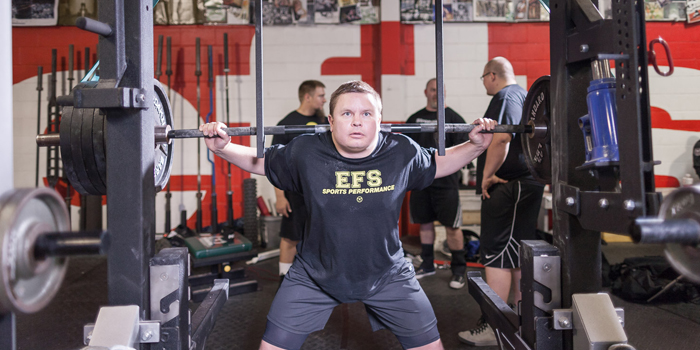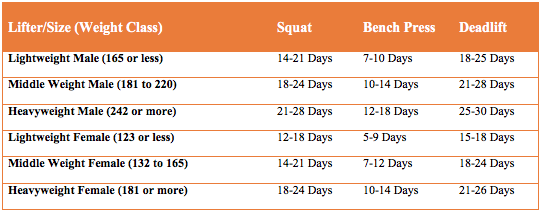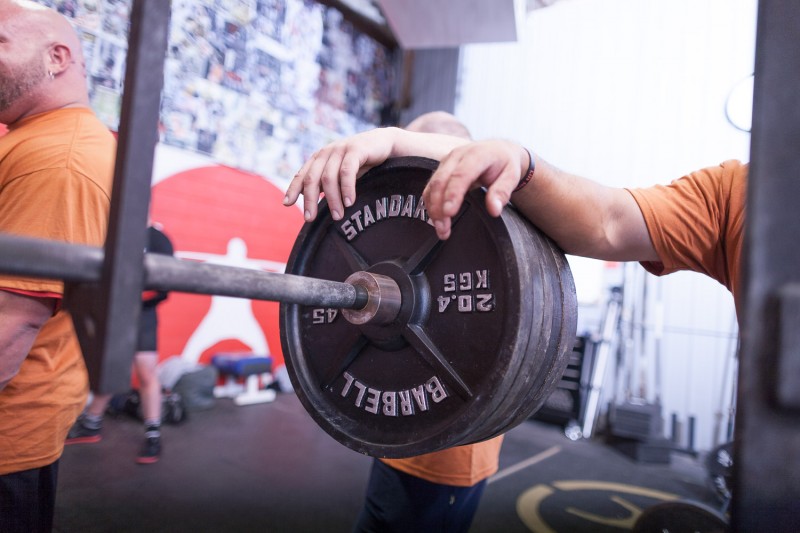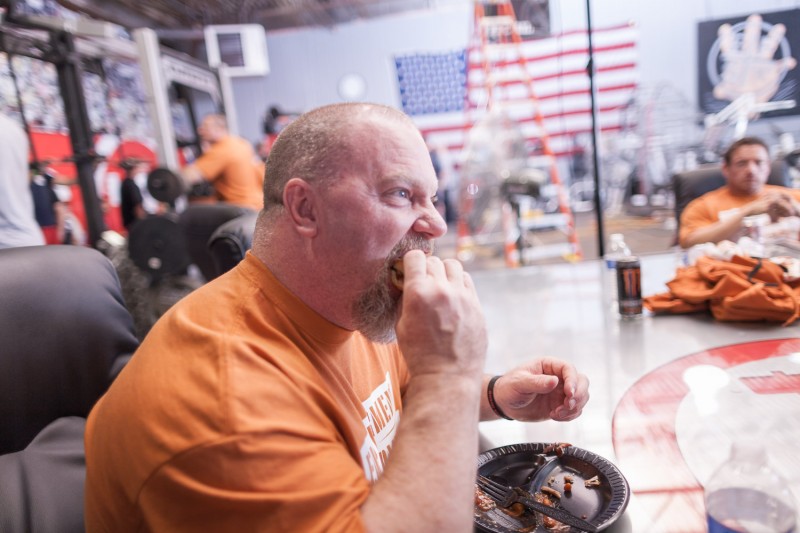
I’ve compiled three articles covering the three competitive lifts for the raw powerlifter: the squat, bench press, and deadlift. The keys to building these lifts and knowing how to program to optimize them are very important. However, your meet strategy and how you are going to put them together to get your best total is what really matters. It’s what you do on meet day, not in training, that counts.
For this article, I’m going to go cover the following:
- Peaking and Programming Concepts
- Meet Strategy and Attempt Selection Guide
- When to Cut Weight
- Optimizing Meet Day Nutrition and Supplementation
There will, of course, be differences from other coaches and lifters, but these are methods that I’ve found to work well for myself and my clients.
Peaking and Programming Concepts
When we’re looking to hit the platform and put together a PR performance, the first step is just having the programming lineup, and working backward from meet day. There will be a lot of generalizations in this section, but that’s merely because each person will have slightly different peaking based on their size, general physical preparation, and frequency of training they are implementing in the off-season and during contest prep.
To understand peaking for a competition, we first need to understand the concept of super-compensation. Super-compensation, in its simplest definition, is the body increasing performance potential above baseline after a brief stint of intentional overtraining (commonly called overreaching) followed by detraining (or deloading). We’re focusing on increasing our performance by overreaching, or an intentional time of overtraining, to force the body to respond greater than normal. We usually would not want to hit a period of overtraining, but we know that we will program a deload period and emphasize rest after the overreaching period is over, and thus super-compensating for meet day.
PART 1: Building the Raw Squat
Now that I’ve got that out of the way, let’s briefly talk about residuals. Residuals are the time frames that certain fitness qualities can be maintained. These should be used in programming concepts regardless of your goal, but for the sake of this article, we are going to talk about strength, hypertrophy, and speed. We could also talk about endurance, but so long as you have a moderate base of aerobic work and general physical preparedness at the beginning of a meet prep, this should take care of itself (and should be the focus of your offseason program).
Strength - Maximal strength has a residual of approximately a month. This is important to know because we need to hit our biggest and strongest lifts of a meet prep cycle within a month of the competition. This can change based on the competitive lift and the size or gender of the athlete and will be mentioned more below.
Hypertrophy - Muscle size has a residual of approximately three weeks. This isn’t to say that you’ll lose all your gains in three weeks, but that the muscle size you’ve acquired has about three weeks until that muscle tissue could begin to atrophy. So, in short, we will need to keep hitting our accessory work until the three weeks out point, especially for specific lagging muscles groups that we know can have carryover to our lifts.
Speed - This quality is probably the most important that we have, as the residual is about five to seven days or a week at the longest. We need to keep training our speed and CAT (compensatory acceleration training) up until a week out. This should really go without saying if you really think about it, but I think it’s a very overlooked quality to training that can help you immensely.
Now that we’ve got these concepts covered, let’s briefly discuss gender, size, and competitive lift specifications to help tie all this together.
Gender - Quite simply, men need more time to recover from training than their female counterpart. This is probably due to the fact that men have greater lean muscle tissue, more testosterone, and can just handle heavier loads than females.
Size - Across the board, a larger person is going to need more time to recover than a smaller one. This is similar to the gender issue: the larger person can just handle more weight in training, and thus the CNS needs more time to recover before a competition.
Competitive Lifts - If you recall from my previous installments, the most taxing lift is the deadlift, followed by the squat, and then the bench press. Knowing this, we can program when we need to take our heaviest lifts in training to allow for the most recovery from each.
Sample Templates
Here are some sample templates for when a competitor would ideally take their heaviest lifts in training while getting ready for a competition. Each competitive lift shows how many days away from competition the competitor would be when they need to take their heaviest attempt.
Meet Strategy and Attempt Selection Guide
Knowing how to put your best lifts together to get a PR total can be a daunting task, and the further you get in your career the more options you have for setting PR totals. Eventually, you’ll even get to a point where you don’t have to hit a single PR all day but can still get a PR total. It all comes down to putting together your best day, not necessarily your best lifts (but at points in your career this will also have to likely happen).
When determining your attempts, here are the percentages I recommend for my clients. These percentages should be based off a clean lift in training that you would give three white lights. Do not use any questionable gym lifts.
- Last Warm-Up (in the warm -up room): 82%-85%
- Opener: 88%-92%
- Second Attempt: 94%-100%
- Third Attempt: 97%-103%
We know that meets will never go your way, and you may need to make adjustments on the fly, but going into meet day, this should be a guideline that your attempts fall under. You can get more aggressive or conservative as the meet goes and your subtotal is known more throughout the day.
PART 2: Building the Raw Bench Press
Here are some general guidelines that I follow for meet days and use when I’m handling lifters:
- Open LIGHT. Pick something you can hit even on bad days.
- If you miss your opener, RETAKE IT. Get in the meet.
- Very rarely will you get a PR total with anything less than a 6/9 day. Make your lifts.
- Base your second and third attempts on the way the previous lift felt. Use auto-regulation and listen to your body. Don’t chase lifts that aren’t there. Chase the total.
With these guides, you should be good to go for meet day. However, ensure that your warm-ups are something you’re used to and you can account for a crazy warm-up if needed. So, plan for the worst where you might only get four to six warm-ups. I’ve been there multiple times and it sucks, but if you can be prepared for that, it’s a little less stressful on meet day. Plan warm-ups to use primarily 45’s, 25’s, and 10’s. Lightweight females will need to use fives here and there, but don’t plan on using two-and-a-half's when figuring out your warm-ups for meet day. They are scarce and you don’t want to depend on them. If they are there, great, but just have a rough game plan. And for heaven’s sake, don’t do a million reps in the warm-up room. Take the bar for a few sets of five if you need to, then start dropping your reps to doubles and triples, and only singles after 50%.
When to Cut Weight
This isn’t something that I really wanted to discuss is this article, but if you’re going to build your raw powerlifting total, there very well might be some point in your career where you cut weight to be more competitive. So, first things first: don’t cut weight if any of the below points apply to you.
- You don’t have an elite total.
- You’re not chasing a top 20 all-time ranking.
- There is no money involved.
- There is no championship involved.
- You don’t need to qualify for another meet (in which one of the above circumstances would happen).
- You’re mentally weak.
- It’s your first meet.
I’m sure I could come up with more, but that should cover most of the circumstances that tick me off. So now the real question: when should you cut weight? Pretty much when you’re at the top of the game for your weight class or there is some serious money or a championship on the line. Getting in a top ranking or chasing a world record is also a viable excuse.
I’m not going to cover the details of my weight cuts and what I do in this article, but if that’s something that you’re interested in, contact me privately. But you should certainly talk with someone experienced and actually good at it (not just the cut, but actually performing well after it) before you do it.
Quite simply, focus on getting stronger.
Optimizing Meet Day Nutrition and Supplementation
Probably one of the biggest issues I see when it comes to people competing is what they are eating (or aren’t eating) as they prepare for their big meet day. Here are some things that will likely help you out on meet day.
Focus On Hydration
Regardless if you cut weight or not, the first thing you need to do after weigh-ins is get some fluid in your body. 99% of the time it should just be water. No Pedialyte or Gatorade, especially if you’ve cut weight. The sugar/dextrose content chugged in the quantities that most powerlifters will consume will likely give you the runs and further dehydrate you. Give your body about 50 ounces of water over the next hour. If you’ve cut weight, still focus on liquids for about two hours before putting down any massive amounts of solid food. The food will slow down your water absorption, and if you’re dehydrated, that’s priority number one.
PART 3: Building the Raw Deadlift
After that, use an electrolyte mix of Gatorade or Pedialyte mixed 50/50 with water. This will dilute the dextrose yet still get you the electrolytes and minerals you need. You should focus on about two gallons of liquid, and perhaps more if you’ve cut weight or are a bigger athlete.
Post Weigh-In Food
The day before a meet, people like to eat like total fatasses, and this baffles me. You’re going to attempt to perform your best, and you’re going to eat crap? Now, I’m not saying eat like a bodybuilder, but don’t go eat greasy food and junk. Eat things like Chipotle, peanut butter and jelly sandwiches, toast, eggs, biscuits, rice, baked potatoes, steak, pretzels, granola bars, etc. You’ll get plenty of sodium and have good energy on meet day. You can have that greasy burger post-meet after you’ve hit PR’s.
Meet Day Food
I suggest eating lower fat foods on meet day. Things that I depend on for meet day are cereal, granola, dried fruit, pretzels, and my electrolyte mixes. It’s enough to keep me going, but not feeling like crap all day.
Supplementation
Supplements can help tremendously in training and on meet day, and here are a few that I would highly recommend:
Multi-Vitamin – While ideally, we get all these from food, it’s likely not going to happen, and if you’ve cut any weight, you’re also likely going to have been deficient for a period of time. It doesn’t really matter that you take a specific one, but I would just be sure it has the basics. I prefer to take one three times the day before the competition, and one the morning of competition.
Creatine Monohydrate – A widely studied supplement and proven to help with strength and performance. However, it’s also an amazing supplement for bloat and water retention, which is incredibly helpful at a powerlifting meet. Taking about 10-15 grams the day before, and another five to 10 grams on meet day should be plenty.
Glucose Disposal Agents (GDA) – What you opt to take here is entirely up to you, and there are a multitude of formulations available. I usually take chromium polynicotinate and alpha linoleic acid. Glucose disposal agents will help maintain healthy blood sugar levels, and may help with storage of glycogen, something very important when you’re ingesting a massive amount of carbohydrates and calories all day long. Just take these with each solid carbohydrate containing meal.
Highly Branched Cyclic Dextrin (HBCD) – This is probably one of the fastest growing supplement products on the market. Its carbohydrate structure is very unique and is excellent for intra-workout training. Knowing this, it makes for a great supplement to use during meet day. I prefer to have 50 grams in my large Nalgene bottle for meet day to keep my glycogen levels capped, energy high, and not have any insulin crashes.
Rounding Things Out
While this article is by no means covering everything that can help you put together your best total, I do feel that there are very vital pieces of information that go overlooked and undervalued when it comes to doing your best on the platform. Take some time to really look at your training, nutrition, sleep, and other factors and see how that can help your overall performance. It’s not always the strongest person that wins in powerlifting; it’s usually the healthiest and smartest that are consistently putting up the best totals and taking home championships.
Best of luck on the platform!














Thank you. Unfortunately, I don't see this happening. I just don't have the experience in the equipment, and quite frankly, this whole series could be applied to an equipped lifter based upon where you are having issues training raw. It would be a good way to improve your raw strength before beginning an equipped training cycle.
This is a great question. Typically I've found is that due how taxing the deadlift is on the nervous system, it turns out to be placed furthest out. There is no real eccentric phase to the lift, which is great in terms of recovery from a muscular standpoint. However, we have to break inertia to even get the lift started, which is very taxing on the CNS. Also, the deadlift is usually trained with less frequency and volume than the squat, therefore the body is usually able to recover quicker from squat training versus deadlift training.
The good thing is, there is overlap between the two lifts, so in this case if you do feel that way, you could still have your squat day further out than your deadlift.
-Javin
Thanks big man. Hope all is going well!
Great advice; although in the technical part of your article, I got lost. But as for the subject of supplementation if that I found interesting. Although apart from Creatine, I would also add L-Carnitine, as there are studies that prove, its effectiveness as a Glucose Saver.
Added to that higher concentrations of Carnitine, in daily intake, can serve enough. I found your article interesting, I'll quote it on my blog, in Spanish.
Thanks for the kind words, I really appreciate it. Best of luck with training, and keep hauling ass!